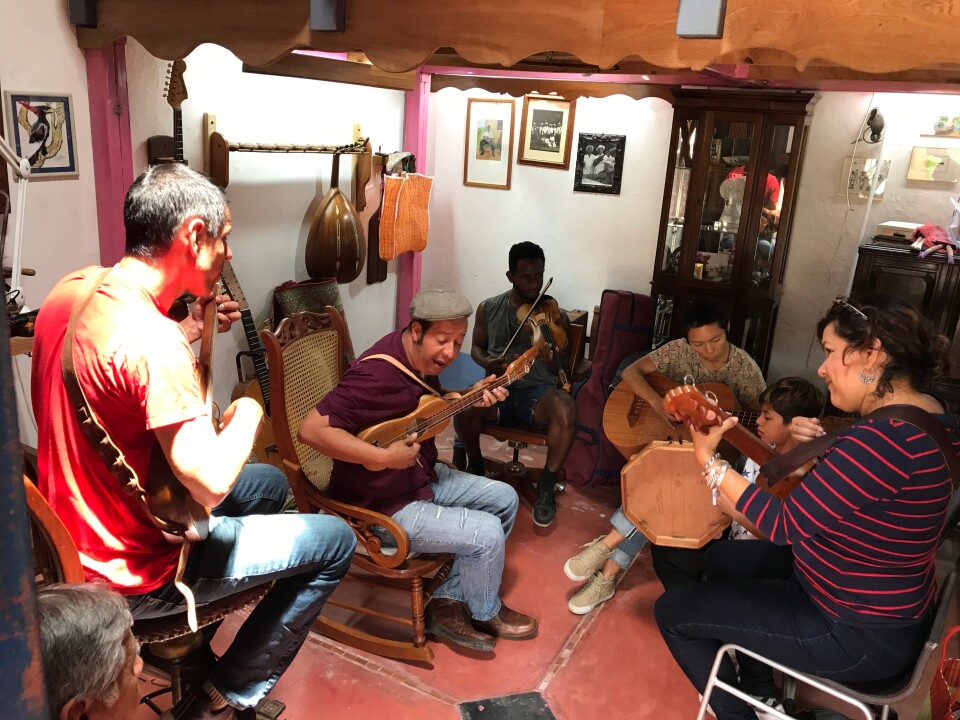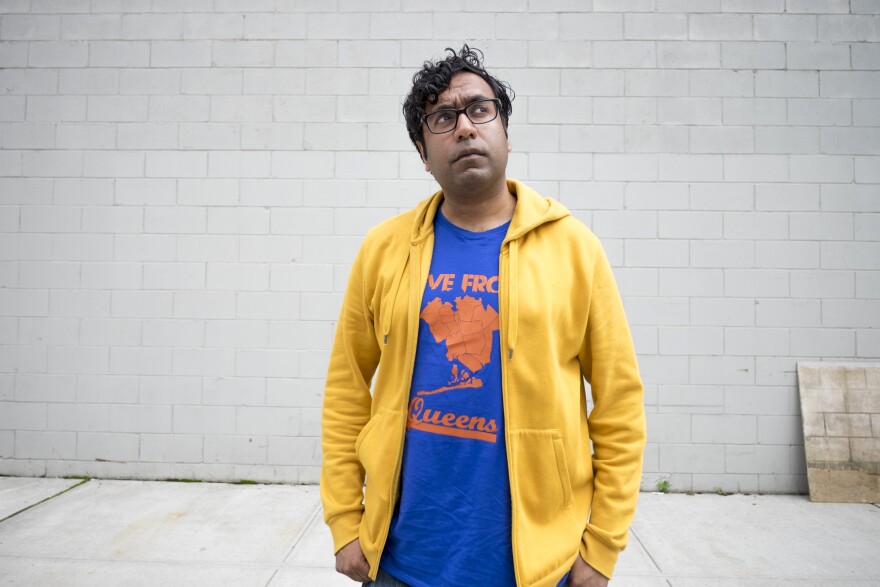Comedian Hari Kondabolu explores his love-hate relationship with “The Simpsons” in a documentary about the show's portrayal of the South Asian store keeper; with The Weinstein Co. out of the picture, Quentin Tarantino is a free agent with his next film; the L.A. band Quetzal explores its musical roots in Veracruz.
Hollywood studios creatively woo Quentin Tarantino for his next movie
In sports, they are called unrestricted free agents — superstar athletes who can sign with whatever team offers the biggest and best deal.
Now that’s happening in Hollywood.
For his entire movie career, filmmaker Quentin Tarantino has worked with Harvey Weinstein, either at Miramax or, more recently, The Weinstein Company. In fact, Weinstein was known to call his studio, “The House That Quentin Built.”
Now that The Weinstein Company is essentially out of business, Tarantino can shop his untitled ninth film all around Hollywood. Not much is known about the film, besides the fact that it’s set in L.A. in 1969 — the same year as the Charles Manson murders. Tom Cruise, Brad Pitt and Margot Robbie are a few names that are rumored to be interested in roles.
There are several studios bidding to produce and distribute the film, but anyone wanting to make the movie has to agree to Tarantino’s very generous contract demands.
We called up Variety senior film and media reporter Brent Lang for the details.
LA band Quetzal revisits its musical roots in Mexico
For more than 20 years, the Grammy Award-winning L.A. band, Quetzal, has incorporated the music and instruments of Mexico’s son jarocho style into its sound. For its next album, the band wanted to revisit the source of this music, so the members recently traveled to Veracruz to immerse themselves in that world.
The first stop was on a hot and humid Sunday afternoon at the home of musicians Tacho Utrera and Wendy Cao-Romero. They live in a coffee region, 10 minutes south of Xalapa, the capital of the Gulf state of Veracruz.
Following tradition, the musicians opened with the song that marks the beginning of the jam session, "El Siquisirí." Cao-Romero welcomed the guests with verses that name-checked Sandino, the 10-year old son of musician Quetzal Flores and singer Martha Gonzalez, leaders of the band.
Cao-Romero said the two families have kept a deep friendship and musical connection for many years and have collaborated on various projects:
“For us, it’s very important that they continue to be interested in our music, because they’re so well-known and they’re a window into the world, as Chicanos and as American musicians.”
On Monday afternoon, the band visited Ramón Gutiérrez at his studio-workshop. He plays the five-string guitar-like instrument called the requinto, and he leads the renowned group Son de Madera.

Flores said the trip to Veracruz had a specific purpose: to immerse the band in the son jarocho environment, and chronicle their time with the music community. Flores said they will bring back the field recordings and create soundscapes that will serve as the foundation for the band's compositions:
“We’re going to compose to these sounds, to these interactions, the voices that you hear of people having conversations, the playing together, the children interacting — all these things are part of the social fabric of who we are and this relationship that we have with the jarocho community.”
Gutiérrez says in the more than 35 years he’s been playing son jarocho, he’s never seen a rock band with the ability to absorb and distill this music like Quetzal:
“I think it’s the only group I’ve seen on stage, playing jaranas and having a very exciting mix of today’s music. It sounds like rock, but you see Martha playing jarana and Quetzal [playing] requinto with pedals.”
On Tuesday afternoon, Quetzal visited a cultural center dedicated to the teaching of son jarocho in the port city of Veracruz. The center was founded in 2001 by Gilberto Gutiérrez, leader of Grupo Mono Blanco, the group that led the son jarocho music and dance renaissance in the early 1980s. Gutiérrez says Quetzal follows in the footsteps of the great Chicano artists, Lalo Guerrero and Los Lobos:
“It’s admirable how they’ve become interested in Mexican culture. It would have been just as easy to disregard it, like many others have done. On the contrary, they have reaffirmed themselves as part of this culture and it’s clearly reflected in the music they make.”
On Wednesday, the band headed three hours south of Veracruz and arrived at El Hato, where in the early 1980s Grupo Mono Blanco jump-started the fandango tradition. Fandango is a celebration of music and dance and is the most significant aspect of son jarocho. Quetzal singer Martha Gonzalez said this visit was enriched by the presence of her son, Sandino:

“It’s really special to see my son here, playing in the same space, to know that there’s more than one generation and that he likes [the music]. Mainly, it’s the fact that he really enjoys it. We don’t make him play. He takes pride in his instrument and, any chance he can, he learns from the big dogs.”
Quetzal Flores said their connection to son jarocho goes well beyond a visit to the source of this musical culture. It’s also about re-establishing relationships with the community, like the musician and instrument-maker, Ramón Gutierrez:
“Sandino has a requinto from Ramón. So we have all these instruments that also have these voices of these people, extensions of their voices. It’s important for us to not just to have an instrument, but know who made it, and the stories behind them and these incredible histories that we connect to in so many ways, and that have created a sense of home in multiple places — for them and for us.”
Flores said this exchange, built on friendship and a strong musical connection, has created a spirit of reciprocity for both communities — in Veracruz and Los Angeles.
Hari Kondabolu on 'The Problem with Apu' and why he's still a 'Simpsons' fan
UPDATE: There’s been a bit of a war of words going on lately between “The Simpsons” and comedian Hari Kondabolu.
In the April 8 "Simpsons" episode, “No Good Read Goes Unpunished," the show finally responded to Kondabolu’s documentary, “The Problem with Apu,” which was released last fall. The documentary uses the "Simpsons" character of Apu – an Indian convenience store owner – as a means of examining the ways South Asians are stereotyped and misrepresented in Hollywood.
When the film first aired in November, 2017, actor Hank Azaria, who voices Apu, had this reaction:
I think the documentary made some really interesting points, and it gave us a lot at The Simpsons to think about, and we really are thinking about it. And definitely anybody that was hurt or offended by it – by any character or vocal performance – it’s really upsetting that that was offensive or hurtful to anybody. And I think it’s an important conversation, and one definitely worth having … We’re just really thinking about it. It’s a lot to digest.
But the show or its producers had not officially responded until the recent episode when Lisa Simpson, in a conversation with her mother, made a comment about political correctness that did not directly address Kondabolu or his film, but was taken as such. Kondabolu responded with this tweet:
Wow. “Politically Incorrect?” That’s the takeaway from my movie & the discussion it sparked? Man, I really loved this show. This is sad.
#TheSimpsons completely toothless response to @harikondabolu #TheProblemWithApu about the racist character Apu:
— soham (@sohamberlamps) April 9, 2018
"Something that started decades ago and was applauded and inoffensive is now politically incorrect... What can you do?" pic.twitter.com/Bj7qE2FXWN— Hari Kondabolu (@harikondabolu)
Wow. “Politically Incorrect?” That’s the takeaway from my movie & the discussion it sparked? Man, I really loved this show. This is sad. https://t.co/lYFH5LguEJ
— Hari Kondabolu (@harikondabolu) April 9, 2018
TruTV will repeat "The Problem with Apu" on April 15 in response to the controversy.
ORIGINAL STORY:
What does the phrase, “Thank you, come again,” mean to you? Maybe not much. But if you’re Indian American or of South Asian descent, it might mean a whole lot.
“Thank you, come again" is the catchphrase of Apu, the Indian immigrant clerk at Springfield’s "Kwik-E-Mart" on "The Simpsons."
Apu is voiced by the decidedly not Indian American actor Hank Azaria. And therein, for comedian and writer Hari Kondabolu, begins the problem.
Kondabolu’s new documentary is called “The Problem with Apu.”
In the documentary, Kondabolu traces the origins of the Apu character and examines the impact of stereotypes in Hollywood. He spoke with The Frame host, John Horn, about why he dislikes the character so much, but still can separate that from his love of "The Simpsons."
Interview highlights:
On the lack of representation of characters of South Asian descent in Hollywood:
When you only have one representation of your community — and [Apu] was the most prominent, the only regular one on television — it ends up becoming defining. That ends up being what your whole community is. There's two issues — I think one is that, the fact that there's still not a broad enough sense of representation. [This year] was a good year for South Asian men, between this documentary I made, Hasan Minhaj's "Homecoming King," Aziz Ansari's show, "Master of None," "The Big Sick" with Kumail Nanjiani. That's a good year for South Asian men, but there's tons of South Asian women whose voices haven't been heard, there's a bunch of people in the LGBTQ community who are South Asian. Each of our communities is much more diverse than we're made to believe. Because part of that — and that leads to the second problem — is, Whose eyes are these these characters being made with? They aren't South Asian eyes, they're not people of color. It's, What do white people see when they see us? And those are the writers, and this is what they see. and this is what they think other people that are like them will find humorous or interesting. So one [solution] is getting the creators to change.
On why he's still a fan of "The Simpsons," and why he understands why other people of South Asian descent, like actor Kal Penn, aren't:
I still love the show, but I understand Kal's perspective. He's also a little bit older than I am, so he had to deal with ... "Indiana Jones," that famous scene with Indian people eating monkey brains. So I think he was probably more sensitized to some degree. And also, as an actor, he was asked to do the Apu voice, so it affected his life and career more than just a childhood thing. The first major role he had in a film was the character Taj Mahal in the movie "Van Wilder." These are the absurd things you had to do when you were starting out. So I understand that. But to me, "The Simpsons" is a net gain for me, by a large margin. It was just kind of weird to love something so much and have it hurt you ... That show taught me how to be funny and smart in so many different ways, and you can criticize something and still love it.
On what he'd like to see "The Simpsons" do with the Apu character going forward:
It's been 30 years, so whatever they do with Apu at this point, it's kind of irrelevant. You know what I mean? If they do it, that's cool. But I'm more concerned with the bigger issues of how are we represented now. Because Apu is kind of like a fossil, right? For some reason, we can still see it actively, but it's a decision that was made 30 years ago in a very different cultural climate ... I don't think they should kill the character, 'cause that's lazy writing. You're "The Simpsons" — write your way out of it! If there's the idea that a stereotype has truth in it, yeah a lot of South Asian immigrants do work at convenience stores, but often they end up buying the stores after working there for a while, and then they own multiple stores and employ other people. How come Apu doesn't have that? You could have someone who could be a counter to Mr. Burns. That's certainly possible. Or you could give his kids a voice — those are young Indian Americans. You can give them a voice and you can let them speak for themselves and represent a new generation.




